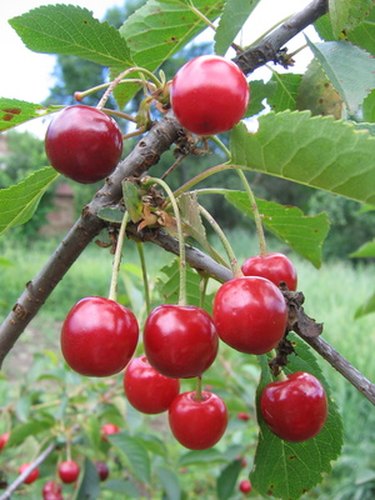Nanking bush cherry plants are not your typical cherry trees. They are smaller, growing to a mature size of 6 to 8 feet tall and branching out 4 to 5 feet wide. They arrive from nursery providers as bare-root stock 12 to 18 inches tall. Growers may find them to be desirable for providing a leafy screen or for producing tasty fruit and sweet-smelling blossoms. Bush cherries are prolific, producing up to 2 gallons of fruit per bush. They are hardy in zones 2 through 8 and should be planted early in the spring, when danger of frost is past.

Video of the Day
Things You'll Need
Mulch
Stakes Or Ribbon
Compost
Step 1
Select a site for your young stock. Bushes will have wide branches when mature, so find a sunny site where they can be spaced at least 4 to 6 feet apart. They may be planted in rows like an orchard; as a border, such as along a drive; or as a screen or property divider. Remove all weeds and grass from the site. If possible, it is helpful to do this the year before in the fall.
Video of the Day
Step 2
Soak the roots of your bare-root stock immediately upon arrival. They should soak for no less than 2 to 3 hours before planting.
Step 3
Dig each hole about 1 to 2 feet wide and 1 foot deep. The depth will depend a bit on the size of your plant's root system. Soil should be dark and crumbly, not too dry, and not too wet so that it clumps together. If you squeeze a ball of dirt in your fist, it should hold together only loosely. Amend the soil with a few handfuls of compost as needed. Don't add fertilizer directly where it will come in contact with young roots. This can cause burning and may subsequently kill the young bush.
Step 4
Set the bush into the hole so that the roots are fanned apart. If you didn't dig the hole deep or wide enough, you should be able to tell. The roots should not be cramped. Refill the hole with loose soil. Avoid clumps, rocks or anything that might smash or damage the roots. Hold the bush upright while refilling, keeping the trunk itself from being buried. There is usually a "bud" where the trunk meets the root system. Keep that bud even with or slightly above the ground surface. Tamp the dirt gently as you fill.
Step 5
Water the bushes generously with 3 to 5 gallons of water. Two or 3 additional gallons of water weekly will help them become well-established. Watering immediately will also help settle air pockets around the root system.
Tip
Mark the bushes. Cherry bushes do not need staking, but you can use stakes or ribbon to make the small bushes visible and to keep them safe from foot traffic and lawn mowers.
Applying a light straw mulch around the young bushes will help to retain moisture in the ground and prevent weed growth.
Catalogs may say that the bushes will produce fruit their first year. This may depend on their zone. Bush cherries grow well in many regions, and northern growers may depend on their hardiness. But it can take as many as four seasons to see production.
Proper pruning during growth can help to speed up production and increase yields.